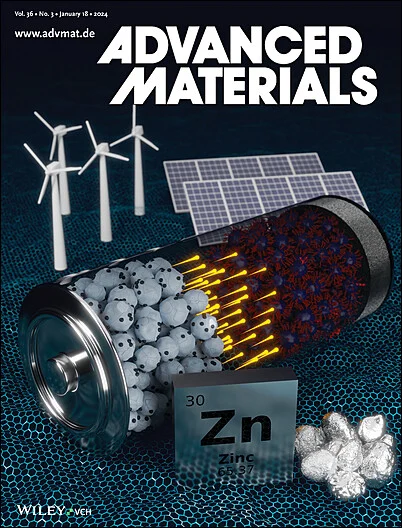利用高效、耐用的有机半导体基光电极实现硝酸盐和甘油的无偏置太阳能升级回收
IF 26.8
1区 材料科学
Q1 CHEMISTRY, MULTIDISCIPLINARY
引用次数: 0
摘要
生物柴油副产品硝酸盐(NO3−)和甘油的可持续管理仍然是一个严峻的环境挑战,破坏了全球氮和碳循环。从材料科学的角度解决了这一问题,提出了一种基于功能能源材料集成的无偏置光电化学(PEC)升级回收系统。镍-铁-磷(Ni - Fe - P)电催化剂在Ni和Fe的氧化还原动力学和磷掺入的电子调制的驱动下,表现出选择性NO3−还原和甘油氧化的协同双功能活性。通过金属箔封装策略,催化剂与基于有机半导体(OS)的光阳极和光电阴极集成在一起,形成了一个高效的基于OS的PEC系统,能够在连续的太阳光照下稳定运行。在AM 1.5G条件下,单个光电极的光电流密度为+15.7和- 14.8 mA cm - 2,同时在60小时后仍保持96%以上的初始性能,表现出卓越的稳定性。为了实现无偏置太阳能升级循环,构建了双光电极PEC结构,提供11.04 mA cm - 2的高反应电流,以及>;95%的法拉第效率和对氨(NH3)和甲酸(FA)生产的优异选择性。这项工作强调了材料驱动的PEC平台在选择性太阳能化学升级回收方面的潜力。本文章由计算机程序翻译,如有差异,请以英文原文为准。
Bias‐Free Solar Upcycling of Nitrate and Glycerol with Highly Efficient and Durable Organic Semiconductor‐Based Photoelectrodes
The sustainable management of biodiesel byproducts, nitrate (NO3 − ) and glycerol, remains a critical environmental challenge, disrupting global nitrogen and carbon cycles. Addressing this issue from a materials science perspective, a bias‐free photoelectrochemical (PEC) upcycling system based on the integration of functional energy materials is presented. A nickel‐iron‐phosphorus (Ni‐Fe‐P) electrocatalyst exhibits synergistic bi‐functional activity for selective NO3 − reduction and glycerol oxidation, driven by the redox dynamics of Ni and Fe and electronic modulation by phosphorus incorporation. Through a metal‐foil encapsulation strategy, the catalyst is integrated with organic semiconductor (OS)‐based photoanodes and photocathodes, forming a highly efficient OS‐based PEC system capable of stable operation under continuous solar illumination. The individual photoelectrodes demonstrate photocurrent densities of +15.7 and−14.8 mA cm−2 under AM 1.5G conditions, while exhibiting remarkable stability with over 96% of initial performance retained after 60 h. To enable bias‐free solar upcycling, a dual‐photoelectrode PEC configuration is constructed, delivering a high reaction current of 11.04 mA cm−2 along with >95% Faradaic efficiencies and excellent selectivity for both ammonia (NH3 ) and formic acid (FA) production. This work underscores the potential of materials‐driven PEC platforms for selective solar chemical upcycling.
求助全文
通过发布文献求助,成功后即可免费获取论文全文。
去求助
来源期刊

Advanced Materials
工程技术-材料科学:综合
CiteScore
43.00
自引率
4.10%
发文量
2182
审稿时长
2 months
期刊介绍:
Advanced Materials, one of the world's most prestigious journals and the foundation of the Advanced portfolio, is the home of choice for best-in-class materials science for more than 30 years. Following this fast-growing and interdisciplinary field, we are considering and publishing the most important discoveries on any and all materials from materials scientists, chemists, physicists, engineers as well as health and life scientists and bringing you the latest results and trends in modern materials-related research every week.
 求助内容:
求助内容: 应助结果提醒方式:
应助结果提醒方式:


